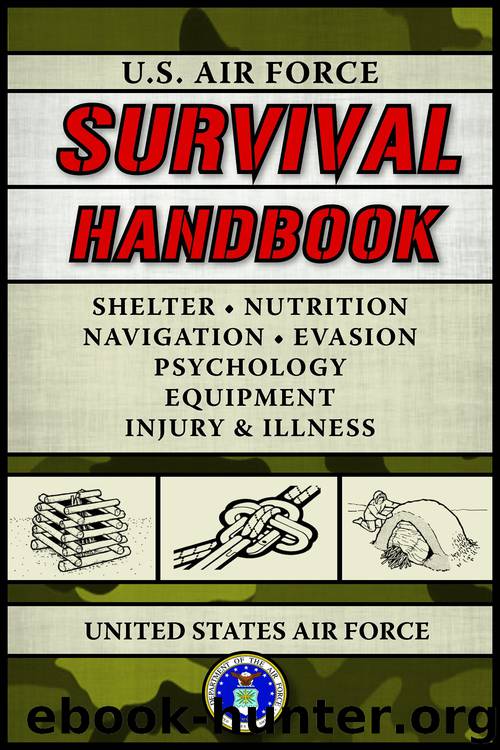U.S. Air Force Survival Handbook by United States Air Force

Author:United States Air Force [Force, United States Air]
Language: eng
Format: epub
Publisher: Skyhorse Publishing, Inc.
Published: 2011-01-24T22:00:00+00:00
Figure 20-4. GNC Map.
Figure 20-5. JNC Map.
Figure 20-6. ONC Map.
Figure 20-7. Operational Navigation Chart Index.
e. Joint Operations Graphic (JOG) (Series 1501 AIR):
(1) JOGs (figure 20-10) are series of 1:250,000 scale military maps designed for joint ground and air operations. The maps are published in ground and air editions. Both series emphasize the air-landing facilities but the air series has additional symbols to identify aids and obstructions to air navigation.
(2) JOG was designed to provide a common-scale graphic for Army, Navy, and Air Force use. Air Forces make use of it for tactical air operations, close air support, and interdiction by medium- and high-speed aircraft at low altitudes. The chart may also be used for dead reckoning and visual pilotage for short-range en route navigation. Due to its large scale, it is unsuitable for local area command planning for strategic and tactical operations.
(a) Relief on the JOG is indicated by contour lines (in feet). In some areas, the intervals may be in meters, with the approximate value in feet indicated in the margin of the chart. Spot elevations are used through all terrain levels. The ground series show elevations and contours in meters while the air series show the same elevations and contours in feet.
(b) Relief is also shown through gradient tints, supplemented by shaded relief. The highest elevations in each 15-minute quadrangle are indicated in thousands and hundreds of feet.
(c) Cultural features, such as cities, towns, roads, trails, and railroads are illustrated in detail. The locations of boundaries and power transmission lines are also shown. Vegetation is shown by symbol. Detailed drainage patterns and water tint are used to illustrate water features, such as coastlines, oceans, lakes, rivers and streams, canals, swamps, and reefs. The JOG includes aeronautical information such as airfields, fixed radio navigation and communication facilities, and all known obstructions over 200 feet above ground. If the information is available, the airfield runway patterns are shown to scale by diagram.
(d) The basic numbering system of the JOG consists of two letters and a number which identifies an area 6° in longitude by 4° in latitude. If the chart covers an area north of the Equator, the first letter is “N;” a chart covering an area south of the Equator is identified with an initial “S.” The second letter identifies the 4° bands of latitude lettered north and south from the Equator. The number identifies the 6° sections of longitude which are numbered from the 180° meridian eastward. The 6° x 4° areas identified by two letters and a number from 1 to 60 are further broken down to either 12 or 16 sheets. Figure 20-11 illustrates how the sheets are numbered in each breakdown. The figure also indicates the respective latitudes at which the 12- and 16-sheet breakdown is used. Charts produced in Canada use a slightly different sheet identification system. The DOD Aeronautical Chart Catalog contains an explanation of the system.
f. DOD Evasion Charts (Figure 20-12). The Defense Mapping Agency and Aeronautical Chart and Information Center prepare DOD evasion charts.
Download
This site does not store any files on its server. We only index and link to content provided by other sites. Please contact the content providers to delete copyright contents if any and email us, we'll remove relevant links or contents immediately.
SAS Survival Handbook by John 'Lofty' Wiseman(2639)
Food and Water in an Emergency by Food & Water In An Emergency(2315)
The Splendid and the Vile by Erik Larson(2307)
Hidden Valley Road by Robert Kolker(2165)
Food Storage for Self-Sufficiency and Survival by Angela Paskett(1936)
Extreme Food - What to Eat When Your Life Depends on It... by Bear Grylls(1739)
The Smartest Kids in the World by Amanda Ripley(1735)
100 Skills You'll Need for the End of the World (as We Know It) by Ana Maria Spagna(1642)
Hawke's Green Beret Survival Manual by Mykel Hawke(1629)
The Survival Savvy Family by Julie Sczerbinski(1589)
How to Invent Everything by Ryan North(1587)
The Knowledge: How to Rebuild our World from Scratch by Lewis Dartnell(1559)
Prepper's Survival Medicine Handbook: A Lifesaving Collection of Emergency Procedures from U.S. Army Field Manuals by Scott Finazzo(1556)
Spy Secrets That Can Save Your Life: A Former CIA Officer Reveals Safety and Survival Techniques to Keep You and Your Family Protected by Jason Hanson(1513)
Lost and Stranded by Timothy Sprinkle(1490)
Mother Earth News Almanac by Mother Earth News(1477)
Prepper's Armed Defense by Jim Cobb(1476)
The Complete U.S. Army Survival Guide to Foraging Skills, Tactics, and Techniques by Jay McCullough(1460)
Brain Rules: 12 Principles for Surviving and Thriving at Work, Home, and School by John Medina(1452)
